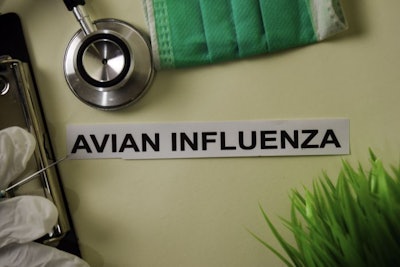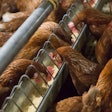
Europe’s poultry sector will be hoping that the coming winter does not turn out to be a repeat of last year’s in terms of a series of highly pathogenic avian influenza (HPAI) outbreaks.
Early signs are not promising. Already in September, the first cases of HPAI were reported in poultry and wild birds in the east of Europe. In the past two months, outbreaks have been reported in Kazakhstan, Ukraine, and four Russian federal districts. Likely sources of infection were migrating birds on-route to or arriving at their winter habitats.
In its latest assessment of the avian flu situation, the European Food Safety Authority (EFSA) stated that HPAI virus has already been detected this autumn in western Russia, and north of the Mongolian border with Russia. As these are key migration areas of wild water-birds, EFSA concluded that the findings present a risk of the possible spread of the virus via wild birds migrating to other parts of Europe.
Although cases of avian flu declined in Europe in the spring and summer, the disease persisted in the north of the region even into September. As a consequence, EFSA warned, the threat of infection to poultry may come from resident wild birds as well as migrating species this year.
For Germany, the first cases of 2020-2012 were in the northern states near to the Baltic Sea and North Sea. This season’s first case has already been detected in Schleswig-Holstein.
Preventative measures to reduce the disease threat
Despite these portents, there are signs that veterinary agencies and poultry farmers may be better prepared for the threat of HPAI this year.
In recent weeks, authorities in France and Poland initiated measures to avoid a repeat of the massive losses those countries incurred from HPAI last year.
Warnings have been issued by governments to their nations’ poultry owners.
In the United Kingdom (U.K.), for example, chief veterinary officers have been urging all poultry owners to improve biosecurity, maintain buildings in good condition, and take care to disinfect footwear before and after entering premises where poultry are kept.
“Making these tasks a regular fixture of your disease control plans now will make a significant difference in the fight against avian flu this winter and for years to come,” said these officials in a recent statement for the government agriculture department, Defra.
Among the latest advice to U.K. poultry keepers is to keep chickens and turkeys separate from ducks and geese. Other measures aim to avoid contact between poultry and wild species, such as fencing outdoor access to keep domestic birds away from wild birds, and placing feed and water in fully enclosed areas.
Recent research from Bioveterinary Research at Wageningen University in the Netherlands has revealed new information on how poultry may be infected with avian flu viruses.
Among the key findings is that there is a low risk of airborne transmission of avian flu viruses from wild species to poultry.
However, researchers confirmed that wild waterfowl — ducks, geese, swans and gulls — are natural reservoirs of these viruses. More likely routes of transmission are through wild bird droppings, and the carcasses of any wild bird that dies near a poultry farm. Even on feathers, they report, the virus can survive for a long time.
HPAI re-emerges in eastern European poultry: Russia, Kazakhstan and Ukraine
Over the past week, Russia’s veterinary authority has officially registered new outbreaks in poultry flocks in four different regions. In each case, and H5 virus has been detected but the strain is not further specified in reports to the World Organisation for Animal Health (OIE).
The only outbreaks described as involving “poultry” in these reports were two in the Republic of Bashkortostan. They represent the first ever detection of this virus strain in the region, which is part of the Volga federal district. Affected were two farms identified as “Altyn Kaz.” More than 4,000 of the geese and turkeys at these units died early in October. The remaining 5,017 birds have been culled to prevent further spread of the infection.
In the other Russian regions where H5 HPAI virus has been detected and reported in the past week, non-commercial poultry flocks have been affected. These include six in the Volga River valley region (Povolzhye) in the federal district of the same name, and one each in Rostov oblast (Southern district) and Belgorod oblast (Central district). These outbreaks directly involved a total of 873 poultry in backyard or village flocks, each with 15-260 birds.
For Belgorod, these cases were the first to be detected in the oblast. The disease has been absent from Rostov since May of this year.
To the OIE, the Republic of Kazakhstan’s veterinary authorities have reported what is described as the first occurrence of H5 HPAI virus in the nation’s poultry flocks.
During the third week of September, this virus variant was detected in two large backyard flocks following elevated mortality. Affected were a flock of around 3,500 birds in the North Kazakhstan region, and 1,000 in Aktobe.
In September of 2020, the H5N8 HPAI virus was detected in Kazakhstan’s poultry flocks. Over the following two months, 11 outbreaks involving more than 670,000 poultry were reported to the OIE. Authorities officially declared the situation “resolved” to the OIE at the end of December last year.
After an absence of more than four months, H5 HPAI virus has been detected again in Mykolaiv oblast in southern Ukraine. More than 40 birds died out of the 118 poultry in a non-commercial flock during the second week of October.
Update on developments elsewhere in European poultry flocks
Earlier this month, one new HPAI outbreak was reported in Kosovo to the European Commission through its Animal Disease Information System.
Italy has detected its first cases of a low-pathogenic avian influenza (LPAI) virus of the H5N1 group of this winter season.
According to the official report to the OIE, three cases were identified in a flock of almost 37,000 birds in the province of Ferrara in Emilia-Romagna. Source of the infection is reported as contact with birds. Among the measures to be applied to the affected premises are selective culling and disposal and disinfection, as well as movement controls inside the country.
Located in the northeast of Italy, the province of Emilia-Romagna saw isolated outbreaks linked to the H5N8 HPAI and H7N7 LPAI viruses early this year.
Since the H5N8 HPAI virus was detected for the first time in Luxembourg early in September, official reports to the OIE indicate no further cases have been detected.
In the Czech Republic too, the number of HPAI outbreaks remains at one. A small flock tested positive for the H5N1 virus variant at the end of last month.
Germany, Serbia report first HPAI cases in wild birds
Following a four-month hiatus, the H5N1 HPAI virus has been detected in the northern German state of Schleswig-Holstein. According to the official report to the OIE, the case was a duck found dead in the North Friesland district earlier this month.
Also registering its first HPAI cases of the winter has been the Republic of Serbia. Since September 20, nine wild swans have tested positive for the H5N8 virus variant in the capital city, Belgrade. The nation had been free of HPAI since April of 2021.
Earlier this month, the veterinary authority of Estonia recorded with the OIE two more wild birds that had tested positive for the H5N8 HPAI virus variant.
In Western Finland, five more pheasants found dead at one location have tested positive for the H5N1 HPAI virus.
View our continuing coverage of the global avian influenza situation
.

















